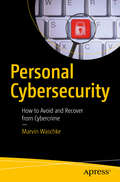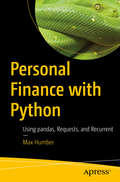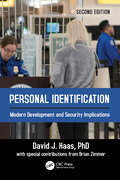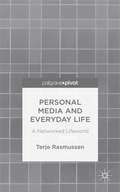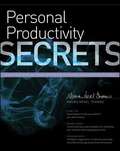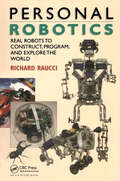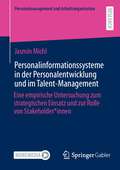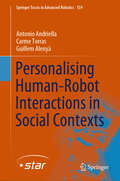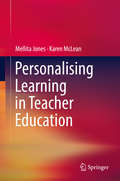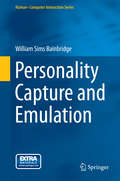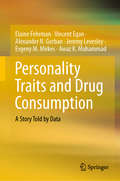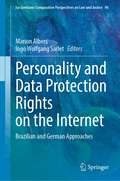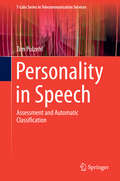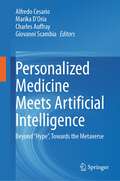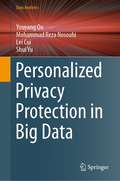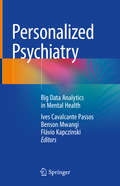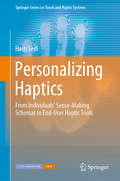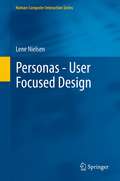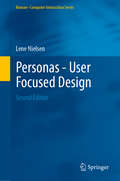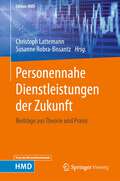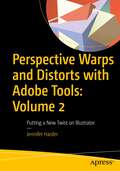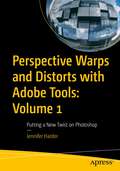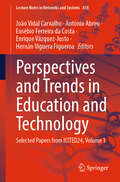- Table View
- List View
Personal Cybersecurity
by Marvin WaschkeDiscover the most prevalent cyber threats against individual users of all kinds of computing devices. This book teaches you the defensive best practices and state-of-the-art tools available to you to repel each kind of threat. Personal Cybersecurity addresses the needs of individual users at work and at home. This book covers personal cybersecurity for all modes of personal computing whether on consumer-acquired or company-issued devices: desktop PCs, laptops, mobile devices, smart TVs, WiFi and Bluetooth peripherals, and IoT objects embedded with network-connected sensors. In all these modes, the frequency, intensity, and sophistication of cyberattacks that put individual users at risk are increasing in step with accelerating mutation rates of malware and cybercriminal delivery systems. Traditional anti-virus software and personal firewalls no longer suffice to guarantee personal security. Users who neglect to learn and adopt the new ways of protecting themselves in their work and private environments put themselves, their associates, and their companies at risk of inconvenience, violation, reputational damage, data corruption, data theft, system degradation, system destruction, financial harm, and criminal disaster. This book shows what actions to take to limit the harm and recover from the damage. Instead of laying down a code of "thou shalt not" rules that admit of too many exceptions and contingencies to be of much practical use, cloud expert Marvin Waschke equips you with the battlefield intelligence, strategic understanding, survival training, and proven tools you need to intelligently assess the security threats in your environment and most effectively secure yourself from attacks. Through instructive examples and scenarios, the author shows you how to adapt and apply best practices to your own particular circumstances, how to automate and routinize your personal cybersecurity, how to recognize security breaches and act swiftly to seal them, and how to recover losses and restore functionality when attacks succeed. What You'll Learn Discover how computer security works and what it can protect us from See how a typical hacker attack works Evaluate computer security threats to the individual user and corporate systems Identify the critical vulnerabilities of a computer connected to the Internet Manage your computer to reduce vulnerabilities to yourself and your employer Discover how the adoption of newer forms of biometric authentication affects you Stop your router and other online devices from being co-opted into disruptive denial of service attacks Who This Book Is For Proficient and technically knowledgeable computer users who are anxious about cybercrime and want to understand the technology behind both attack and defense but do not want to go so far as to become security experts. Some of this audience will be purely home users, but many will be executives, technical managers, developers, and members of IT departments who need to adopt personal practices for their own safety and the protection of corporate systems. Many will want to impart good cybersecurity practices to their colleagues. IT departments tasked with indoctrinating their users with good safety practices may use the book as training material.
Personal Finance with Python: Using Pandas, Requests, And Recurrent
by Max HumberDeal with data, build up financial formulas in code from scratch, and evaluate and think about money in your day-to-day life. This book is about Python and personal finance and how you can effectively mix the two together. In Personal Finance with Python you will learn Python and finance at the same time by creating a profit calculator, a currency converter, an amortization schedule, a budget, a portfolio rebalancer, and a purchase forecaster. Many of the examples use pandas, the main data manipulation tool in Python. Each chapter is hands-on, self-contained, and motivated by fun and interesting examples.Although this book assumes a minimal familiarity with programming and the Python language, if you don't have any, don't worry. Everything is built up piece-by-piece and the first chapters are conducted at a relaxed pace. You'll need Python 3.6 (or above) and all of the setup details are included.What You'll LearnWork with data in pandasCalculate Net Present Value and Internal Rate ReturnQuery a third-party API with RequestsManage secretsBuild efficient loopsParse English sentences with RecurrentWork with the YAML file formatFetch stock quotes and use Prophet to forecast the futureWho This Book Is ForAnyone interested in Python, personal finance, and/or both! This book is geared towards those who want to manage their money more effectively and to those who just want to learn or improve their Python.
Personal Identification: Modern Development and Security Implications
by David J. HaasPersonal Identification: Modern Development and Security Implications, Second Edition explains how personal identification – and REAL ID – became part of the American fabric along with their past century’s historical ID development. The development of the “trusted and secure” personal identification documents began with passports and has continued as social changes made IDs more essential. This book describes the convergence of technologies and hundreds of patents that produced our “trusted and secure” documents and IDs from our past right up through to today.Key factors, that created today’s need for public-issued mass ID, are addressed: Chronicles the effects of large and mobile populations beginning a century ago Chronicles the effects of “impersonal” electronic & computer communications at a distance, and not face-to-face The distribution of services and money by government agencies based on a person’s identity – including “age” and “group” criteria Describes recent national security and terrorism concerns that necessitates the need to know: “You are who you say you are.” Personal identification documents (IDs) and the societal need for “trusted” identification by the public is a relatively new social phenomenon. In 1900, most people did not need or have any IDs until passports, with a photograph of the individual, became mandatory when Great Britain entered World War I in 1914. In the United States, the State-issued driver’s license is probably the only trusted ID in one’s wallet today, but they became “trusted and secure” documents only recently with the requirement for REAL ID. With the first photo driver’s license issued by the State of Colorado in 1959, it took until 1984 for the last State (New York, 25 years later) to comply.As a direct result of 9/11, where terrorists used fake driver’s licenses to board planes, Congress passed the Real ID Act in 2005 to make all State-issued driver’s licenses more trusted, uniform, and tamper-resistant – what is now called the Enhanced Driver’s License with non-drivers being issued Enhanced Identification Cards. And with this, every US citizen can now possess a trusted and secure personal identification document.Personal Identification, Second Edition chronicles the path of personal identification measures – including the latest developments of Real ID. Scholars and professional security managers understand that stability, security, and safety necessitate these identity measures to ensure a safer America. The book explains the various stages and advances, providing readers with a unique study of this fascinating history of the relationship between identity and the means by which one validates and proves their own identity. The enactment of the REAL ID Act of 2005, with more secure and tamper-resistant documents for each citizen of the United States, is being instituted so that one can trust: “you are who you say you are.” The State-issued driver’s license is not a National ID Card – it is a Nationally Recognized ID for each citizen.
Personal Media and Everyday Life: A Networked Lifeworld
by Terje RasmussenThis book addresses the widespread use of digital personal media in daily life. With a sociological and historical perspective, it explores the media-enhanced individualization and rationalization of the lifeworld, discussing the dramatic mediatization of daily life and calling on theorists such as McLuhan, Habermas and Goffman.
Personal Multimedia Preservation
by Vasileios Mezaris Claudia Niederée Robert H. LogieThis unique text/reference advocates a novel forgetful approach to dealing with personal multimedia content in the long run, which is inspired by the effectiveness of human forgetting as a mechanism for helping us to stay focused on important things. The text presents theoretical foundations, technologies, applications, and case study results that help the reader to understand the problems and challenges associated with personal digital preservation, and the solutions that can be developed in response to these challenges.Topics and features: Highlights the value of an intelligent and selective approach to personal multimedia preservation, involving managed forgetting and contextualized remembering; considers how a conceptual understanding of human memory function can be used to inspire the design of digital managed preservation and forgetting; discusses methods that endow computers with capabilities to understand digital content, in order to support intelligent preservation decisions; examines the assessment of the importance of information items, introducing the concepts of memory buoyancy and preservation value; reviews methods for preserving the context associated with a digital item, and for assessing how this context evolves over time; proposes a reference model for the Preserve-or-Forget (PoF) approach which is integrative, value-driven, brain-inspired, forgetful, and evolution-aware; describes the integration of preservation functionalities in a Personal Information Management (PIM) application; presents a user study on a photo selection task, using the results to design methods for automatically selecting important photos from personal collections.This interdisciplinary volume provides significant insights from computer science, engineering and psychology that will be of great interest to researchers involved in multimedia and software engineering, multimedia preservation, cultural informatics, digital heritage, and the digital humanities.
Personal Power: The iOS Edition
by Michael FeirPersonal Power; The iOS Edition is a guide for blind people who either own or are interested in using iOS devices made by Apple. Namely, iPHONEs, iPAds and iPODs. No prior experience is presumed.
Personal Productivity Secrets
by Maura Nevel ThomasLearn tried-and-tested methods for optimal personal productivity!Ever find yourself more than a bit overwhelmed by the constant influx of e-mail and reminders as well as the ever-present calendars, to-do lists, miscellaneous paper, and sticky notes? Add to that, myriad devices that were originally intended to make us more efficient, but in reality, only end up forcing us to juggle even more. Our brains aren't wired for all this, but we can learn to be productive. Personal Productivity Secrets gives you everything you need to know to be organized, in control, and to get things done:Understand how your brain absorbs, organizes, and filters the daily deluge of information, and learn to trick your brain into being more productive Appreciate the difference between "Time Management" and "Attention Management" and create workflow processes that help you defend your attention Create a plan for navigating endless technology options, and implement tools that will keep you productive, focused and in control Personal Productivity Secrets reveals updated and vital information for achieving your significant results, and being as productive as you can be in a fast-paced, technology-driven society.
Personal Robotics: Real Robots to Construct, Program, and Explore the World
by Richard RaucciMany companies are now offering robots that are geared to the casual electronics hobbyist, both in kit form and as fully assembled models. This book gives an overview of available robot products, ranging from the simple to the complex. Interested readers will be able to find the robot kit that matches their skill level and pocketbook. Beginners may want to try a robot that is already fully assembled, or a kit with pre-assembled electronics. Other readers may opt for kits that require soldering and electronic experience. Other criteria a reader will be able to review include motion systems (robots that roll on wheels, or walk on legs, or robot arms), available sensors (from none to a wide range), and programming complexity (how the robot is programmed). If its not really a robot, its not in this book.
Personalinformationssysteme in der Personalentwicklung und im Talent-Management: Eine empirische Untersuchung zum strategischen Einsatz und zur Rolle von Stakeholder*innen (Personalmanagement und Arbeitsorganisation)
by Jasmin MichlJasmin Michl realisiert eine tiefgehende Untersuchung zum Einsatz von Personalinformationssystemen in der Personalentwicklung und im Talent-Management mit besonderem Fokus auf strategische Einsatzgebiete und die Rolle von Stakeholder*innen. Im Rahmen ihrer Analyse verbindet die Autorin Perspektiven unterschiedlicher Interessengruppen, um die zentralen Herausforderungen digitaler Einführungsvorhaben im Personalbereich für Unternehmen und ihre Mitarbeitenden herauszuarbeiten. Hierbei wird auf Grundlage eines Mixed-Methods-Ansatzes deutlich, dass die erfolgreiche Bewältigung von technologischen Einführungsprojekten in HR keine rein technische Frage darstellt, sondern vielmehr eine der organisationalen Rahmenbedingungen und der sozialen Transformation. Die Erkenntnisse der Untersuchung bieten einen Einblick in transformationale Bewältigungs- und Positionierungsprobleme von und in Organisationen und bieten eine Grundlage zur Erarbeitung von möglichen Handlungs- und Zielfeldern für die Praxis.
Personalising Human-Robot Interactions in Social Contexts (Springer Tracts in Advanced Robotics #159)
by Carme Torras Antonio Andriella Guillem AlenyàThis book offers an insightful exploration of the pivotal role of robots in our ever-changing society. As intelligent machines become increasingly integrated into various aspects of our lives, their impact on how we live, work, and interact becomes undeniable. Within these pages, the book delves into the key concept of personalisation, unravelling the profound importance of tailoring robotic interactions to meet the unique needs and preferences of individuals. This exploration seeks to foster a deeper understanding of how robots can enhance our lives and potentially be a worthwhile technology to address some important societal issues. To showcase that, the book centres on a practical use case that is built upon collaboration with healthcare experts: designing personalised robots for assisting patients affected by cognitive decline. With over 50 million people affected by dementia worldwide and an expected tripling of this number by 2050, the need for effective and accessible treatments is more pressing than ever. While there are no pharmacological treatments for this syndrome, cognitive training has shown promise for maintaining and even improving cognitive functioning among dementia patients. However, the shortage of healthcare professionals capable of delivering such therapy presents a significant challenge. This is where the potential of robots comes into play. This book delves into the potential of robotic technology designed to bridge this societal gap. By taking a therapist-oriented approach, it investigates the insights that can be gleaned from involving therapists in the entire pipeline of the design process as well as in the automatisation of the robots' assistive behaviour. Specifically, this book aims to address personalisation from two complementary perspectives by designing robots that are both adaptable and adaptive.
Personalising Learning in Teacher Education
by Mellita Jones Karen McLeanThis volume sheds light on debates about personalised learning in teacher education by exploring the popular emergence of personalising learning in education and hence its significance in teacher education in the 21st century. It examines personalising learning theory and explores the tenets of this theory and its recent trends in international settings. The theory is explored in relation to both general and higher education pedagogy, and in a range of examples within a teacher education context. The examples from practice provide insights into maximising the potential for personalising learning theory to enhance teaching, learning and assessment in teacher education. The book includes case studies involving pre-service teachers working in communities of practice with one another, with schools and with the wider community. Examples of technology for personalising learning are also described. All the case studies demonstrate how the learner is made central to the teaching and assessment approaches adopted and contributes to a lifelong learning continuum. Providing insights into a new pedagogy for teacher education that leads to an enriched student experience, the book presents a model for personalising learning in teacher education that offers support for 21st century teacher educators.
Personality Capture and Emulation
by William Sims BainbridgePersonality Capture and Emulation is the gateway to an amazing future that actually may be achieved, enabling the preservation and simulation of human personalities at progressively higher levels of fidelity. This challenge is no longer the province merely of uninhibited visionaries, but has become a solid field of research, drawing upon a wide range of information technologies in human-centered computing and cyber-human systems. Even at modest levels of accomplishment, research in this emerging area requires convergence of cognitive, social, and cultural sciences, in cooperation with information engineering and artificial intelligence, thus stimulating new multidisciplinary perspectives. Therefore this book will inspire many specific research and development projects that will produce their own valuable outcomes, even as the totality of the work moves us closer to a major revolution in human life. Will it ever really be possible to transfer a human personality at death to a technology that permits continued life? Or will people come to see themselves as elements in a larger socio-cultural system, for which a societal information system can provide collective immortality even after the demise of individuals? A large number and variety of pilot studies and programming projects are offered as prototypes for research that innovators in many fields may exploit for the achievement of their own goals. Together, they provide an empirical basis to strengthen the intellectual quality of several current debates at the frontiers of the human and information sciences.
Personality Traits and Drug Consumption: A Story Told by Data (SpringerBriefs in Statistics)
by Alexander N. Gorban Jeremy Levesley Elaine Fehrman Vincent Egan Evgeny M. Mirkes Awaz K. MuhammadThis book discusses the psychological traits associated with drug consumption through the statistical analysis of a new database with information on 1885 respondents and use of 18 drugs. After reviewing published works on the psychological profiles of drug users and describing the data mining and machine learning methods used, it demonstrates that the personality traits (five factor model, impulsivity, and sensation seeking) together with simple demographic data make it possible to predict the risk of consumption of individual drugs with a sensitivity and specificity above 70% for most drugs. It also analyzes the correlations of use of different substances and describes the groups of drugs with correlated use, identifying significant differences in personality profiles for users of different drugs. The book is intended for advanced undergraduates and first-year PhD students, as well as researchers and practitioners. Although no previous knowledge of machine learning, advanced data mining concepts or modern psychology of personality is assumed, familiarity with basic statistics and some experience in the use of probabilities would be helpful. For a more detailed introduction to statistical methods, the book provides recommendations for undergraduate textbooks.
Personality and Data Protection Rights on the Internet: Brazilian and German Approaches (Ius Gentium: Comparative Perspectives on Law and Justice #96)
by Marion Albers Ingo Wolfgang SarletThis book focuses on protection needs and new aspects of personality and data protection rights on the Internet, presenting a comprehensive review that discusses and compares international, European and national (Brazilian, German, Pakistani) perspectives. It deals with overarching questions, such as whether universal minimum standards of privacy protection can be developed or how regional data protection rights can be safeguarded and enforced extraterritorially, given the conditions of the Internet. Furthermore, the book addresses new challenges and novel rights, e. g., data retention and protection against mass surveillance, the right to be forgotten, rights to anonymity, legal issues of the digital estate or rights relating to algorithmic decision-making. Furthermore, the book explores how well-known paradigms, such as liability for personality rights violations or damages, have to be adapted in view of the significant role of intermediaries.
Personality in Speech
by Tim PolzehlThis work combines interdisciplinary knowledge and experience from research fields of psychology, linguistics, audio-processing, machine learning, and computer science. The work systematically explores a novel research topic devoted to automated modeling of personality expression from speech. For this aim, it introduces a novel personality assessment questionnaire and presents the results of extensive labeling sessions to annotate the speech data with personality assessments. It provides estimates of the Big 5 personality traits, i. e. openness, conscientiousness, extroversion, agreeableness, and neuroticism. Based on a database built on the questionnaire, the book presents models to tell apart different personality types or classes from speech automatically.
Personalized Medicine Meets Artificial Intelligence: Beyond “Hype”, Towards the Metaverse
by Alfredo Cesario Marika D’Oria Charles Auffray Giovanni ScambiaThe book provides a multidisciplinary outlook on using Artificial Intelligence (AI)-based solutions in the field of Personalized Medicine and its transitioning towards Personalized Digital Medicine.The first section integrates different perspectives on AI-based solutions and highlights their potential in biomedical research and patient care. In the second section, the authors present several real-world examples that demonstrate the successful use of AI technologies in various contexts. These include examples from digital therapeutics, in silico clinical trials, and network pharmacology. In the final section of the book, the authors explore future directions in AI-enhanced biomedical technologies and discuss emerging technologies such as blockchain, quantum computing and the “metaverse”. The book includes discussions on the ethical, regulatory, and social implications for an AI-based personalized medicine. The integration of heterogeneous disciplines brings together multiple stakeholders and decision makers involved in the personalization of care. Clinicians, students, and researchers from academia and the industry can benefit from this book, since it provides foundational knowledge to drive advances in personalized biomedical research and health care.
Personalized Privacy Protection in Big Data (Data Analytics)
by Shui Yu Youyang Qu Mohammad Reza Nosouhi Lei CuiThis book presents the data privacy protection which has been extensively applied in our current era of big data. However, research into big data privacy is still in its infancy. Given the fact that existing protection methods can result in low data utility and unbalanced trade-offs, personalized privacy protection has become a rapidly expanding research topic.In this book, the authors explore emerging threats and existing privacy protection methods, and discuss in detail both the advantages and disadvantages of personalized privacy protection. Traditional methods, such as differential privacy and cryptography, are discussed using a comparative and intersectional approach, and are contrasted with emerging methods like federated learning and generative adversarial nets.The advances discussed cover various applications, e.g. cyber-physical systems, social networks, and location-based services. Given its scope, the book is of interest to scientists, policy-makers, researchers, and postgraduates alike.
Personalized Psychiatry: Big Data Analytics in Mental Health
by Ives Cavalcante Passos Benson Mwangi Flávio KapczinskiThis book integrates the concepts of big data analytics into mental health practice and research.Mental disorders represent a public health challenge of staggering proportions. According to the most recent Global Burden of Disease study, psychiatric disorders constitute the leading cause of years lost to disability. The high morbidity and mortality related to these conditions are proportional to the potential for overall health gains if mental disorders can be more effectively diagnosed and treated. In order to fill these gaps, analysis in science, industry, and government seeks to use big data for a variety of problems, including clinical outcomes and diagnosis in psychiatry. Multiple mental healthcare providers and research laboratories are increasingly using large data sets to fulfill their mission. Briefly, big data is characterized by high volume, high velocity, variety and veracity of information, and to be useful it must be analyzed, interpreted, and acted upon. As such, focus has to shift to new analytical tools from the field of machine learning that will be critical for anyone practicing medicine, psychiatry and behavioral sciences in the 21st century. Big data analytics is gaining traction in psychiatric research, being used to provide predictive models for both clinical practice and public health systems. As compared with traditional statistical methods that provide primarily average group-level results, big data analytics allows predictions and stratification of clinical outcomes at an individual subject level.Personalized Psychiatry – Big Data Analytics in Mental Health provides a unique opportunity to showcase innovative solutions tackling complex problems in mental health using big data and machine learning. It represents an interesting platform to work with key opinion leaders to document current achievements, introduce new concepts as well as project the future role of big data and machine learning in mental health.
Personalizing Haptics: From Individuals' Sense-Making Schemas to End-User Haptic Tools (Springer Series on Touch and Haptic Systems)
by Hasti SeifiThis monograph presents a vision for haptic personalization tools and lays the foundations for achieving it. Effective haptic personalization requires a suite of tools unified by one underlying conceptual model that can easily be incorporated into users’ workflows with various applications. Toward this vision, the book introduces three mechanisms for haptic personalization and details development of two of them into: 1) an efficient interface for choosing from a large haptic library, and 2) three emotion controls for adjusting haptic signals. A series of quantitative experiments identifies five schemas (engineering, sensation, emotion, metaphor, and usage examples) for how end-users think and talk about haptic sensations and characterizes them as the underlying model for the personalization tools. Personalizing Haptics highlights the need for scalable haptic evaluation methodologies and presents two methodologies for large-scale in-lab evaluation and online crowdsourcing of haptics. While the work focuses on vibrotactile signals as the most mature and accessible type of haptic feedback for end-users, the concepts and findings extend to other categories of haptics. Taking haptics to the crowds will require haptic design practices to go beyond the current one-size-fits-all approach to satisfy users’ diverse perceptual, functional, and hedonic needs reported in the literature. This book provides a starting point for students, researchers, and practitioners in academia or industry who aim to adapt their haptic and multisensory designs to the needs and preferences of a wide audience.
Personas - User Focused Design
by Lene NielsenPeople relate to other people, not to simplified types or segments. This is the concept that underpins this book. Personas, a user centered design methodology covers topics from interaction design within IT, through to issues surrounding product design, communication, and marketing. Project developers need to understand how users approach their products from the product's infancy, and regardless of what the product might be. Developers should be able to describe the user of the product via vivid depictions, as if they - with their different attitudes, desires and habits - were already using the product. In doing so they can more clearly formulate how to turn the product's potential into reality. With contributions from professionals from Australia, Brazil, Finland, Japan, Russia, and the UK presenting real-world examples of persona method, this book will provide readers with valuable insights into this exciting research area. The inspiration to create user descriptions includes character-driven narratives, and the film Thelma & Louise is analyzed in order to understand how the development process can also be an engaging story in various professional contexts. With a solid foundation in her own research at the IT University of Copenhagen and more than five years of experience in solving problems for businesses, Lene Nielsen is Denmark's leading expert in the persona method. She has a PhD in personas and scenarios, and through her research and practical experiences she has developed her own approach to the method - 10 Steps to Personas. Personas - User Focused Design presents a step-by-step methodology of personas which will be of interest to developers of IT, communications solutions and innovative products.
Personas - User Focused Design: User Focused Design (Human–Computer Interaction Series #15)
by Lene NielsenPeople relate to other people, not to simplified types or segments. This is the concept that underpins this book. Personas, a user centered design methodology, covers topics from interaction design within IT, through to issues surrounding product design, communication, and marketing. Project developers need to understand how users approach their products from the product’s infancy, and regardless of what the product might be. Developers should be able to describe the user of the product via vivid depictions, as if they – with their different attitudes, desires and habits – were already using the product. In doing so they can more clearly formulate how to turn the product's potential into reality. Based on 20 years’ experience in solving problems for businesses and 15 years of research, currently at the IT University of Copenhagen, Lene Nielsen is Denmark’s leading expert in the persona method. She has a PhD in personas and scenarios, and through her research and practical experiences has developed her own approach to the method – 10 Steps to Personas. This second edition of Personas – User Focused Design presents a step-by-step methodology of personas which will be of interest to developers of IT, communications solutions and innovative products. This book also includes three new chapters and considerable expansion on the material in the first edition.
Personennahe Dienstleistungen der Zukunft: Beiträge aus Theorie und Praxis (Edition HMD)
by Christoph Lattemann Susanne Robra-BissantzDie digitale Transformation fordert und befördert personennahe Dienstleistungen. Dienstleistungen, die Menschen in ihrem Leben unterstützen. Dieses Buch bietet wertvolle Anregungen dazu, wie personennahe Dienstleistungen über digitale Plattformen oder Prozesse gestalten werden können. Dabei setzt es am persönlichen Leben an und bietet Forschungsergebnisse und Praxiserfahrungen aus drei Anwendungsbereichen: zu Hause und im Wohnumfeld, im individuellen privaten oder beruflichen Leben, sowie im Umfeld von Bildung und Wissenschaft. Das Buch liefert Inspirationen für Forschungsprojekte, die aus digitalen Technologien eine personennahe Dienstleistung entwickeln, aber auch für jedes Unternehmen, das eine gute Idee zu einem marktreifen Angebot wandeln muss. Es ist damit ein Must-Read für alle Praktiker*innen und Forscher*innen, die sich mit der digitalen Transformation beschäftigen und dieser theoretisch – auf Basis der Service Logik - und für heutige Märkte mithilfe der Gestaltung innovativer, personennaher Dienstleistungen begegnen wollen.Wie typisch für die Fachbuchreihe Edition HMD greifen die Beiträge das Thema aus Sicht von Forschung und Praxis auf. In diesem Buch wird dabei jeweils ein Beispiel personennaher Dienstleistungen einmal wissenschaftlich und einmal aus dem praktischen Blickwinkel betrachtet.
Perspective Warps and Distorts with Adobe Tools: Putting a New Twist on Illustrator
by Jennifer HarderGain skills in illustration and logo manipulation that will enhance your designs and make them more appealing--either in your portfolio or for your client’s next graphic project.As Adobe's Photoshop and Illustrator have evolved, new and unique features have been added to these programs that offer different options for warping and distorting graphics and shapes. For the beginner and intermediate student or graphic artist, choosing or knowing which distort or warp tool to use among so many available can become overwhelming and confusing.This book primarily focuses on teaching how to work with various warping tools and effect filters in Illustrator, though you will also be using or comparing graphics from Adobe Photoshop. Knowing how to work between these two applications is a crucial part of understanding how to successfully manipulate your designs. In Illustrator, you'll see how to alter vector graphics, and learn how to do this with your Layers panel in various non-destructive ways. Some of the tools mentioned in this book will be familiar to you, as you may have used them frequently. However, others are well hidden, are new, or perhaps you have never considered that you could use that tool, dialog box, or filter effect to warp or distort. What You Will LearnBecome proficient in using the warping and distorting tools and effects in IllustratorDiscover how to add perspective to your design or make them look three dimensional Work with the Appearance panel, Graphic Styles, and SymbolsCombine older tools and newer, enhanced onesWho This Book Is ForBeginner- and Intermediate-level readers interested in pursuing careers as graphic artists, photographers, or video artists/animators.
Perspective Warps and Distorts with Adobe Tools: Putting a New Twist on Photoshop
by Jennifer HarderGain skills in image and logo manipulation that will enhance your designs and make them more appealing--either in your portfolio or for your client’s next graphic project.As Adobe's Photoshop and Illustrator have evolved, new and unique features have been added to these programs that offer different options for warping and distorting graphics and shapes. For the beginner and intermediate student or graphic artist, choosing or knowing which distort or warp tool to use among so many available can become overwhelming and confusing.This book primarily focuses on teaching how to work with various warping tools and filters in Photoshop, though you will also be using graphics acquired from Adobe Illustrator. Knowing how to work between these two applications is a crucial part of understanding how to successfully manipulate your designs. In Photoshop, you'll see how to alter both raster images and vector graphics, and learn how to do this with layers in various non-destructive ways. Some of the filters mentioned in this book will be familiar to you, as you may have used them frequently. However, others are well hidden, are new, or perhaps you have never considered that you could use that tool, dialog box, or filter to warp or distort. What You Will LearnBecome proficient in using the warping and distorting tools and filters in Photoshop, as well as how to correct basic distortions in photos and add perspectiveGrasp transferring illustrations from Illustrator for use in PhotoshopDiscover how to warp and distort typeGenerate unique patternsWork with Smart Object Layers and Smart FiltersWork in combination with older tools and newer, enhanced ones Who This Book Is ForBeginner- and Intermediate-level readers interested in pursuing careers as graphic artists, photographers, or video artists/animators.
Perspectives and Trends in Education and Technology: Selected Papers from ICITED24, Volume 1 (Lecture Notes in Networks and Systems #858)
by António Abreu João Vidal Carvalho Eusébio Ferreira da Costa Enrique Vázquez-Justo Hernán Viguera FigueroaThis book from the LNNS Series is composed of the best selected papers accepted for presentation and discussion at the 2024 International Conference in Information Technology & Education (ICITED’24). The ICITED is a multidisciplinary conference with a special focus on new Technologies and Systems in the Education sector and was held between July 11 and 13, 2024. The ICITED’24 was supported by the Pernambuco University, Recife, Brazil, and by IADITI—International Association for Digital Transformation and Technological Innovation. The International Conference in Information Technology & Education is an international forum for researchers and professionals in the education sector, which enables the discussion of the latest innovations, trends, and concerns in several areas, in the education sector, associated with information technologies and systems. It is an event for professionals in the sector, in search of technology solutions, where academics, IT experts, and business managers meet to discuss new ideas that help them maximize the potential of learning processes through technology. The ICITED’24 Scientific Committee is composed of a multidisciplinary group of 143 experts who assessed some 262 papers from 26 countries, received for each of the main topics proposed for the conference. The papers accepted for presentation and discussion at the conference are published by Springer and will be submitted for indexing by ISI, SCOPUS, EI-Compendex, Google Scholar, and SpringerLink.
